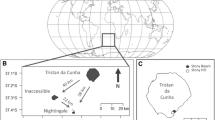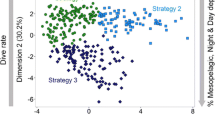Abstract
Penguins may exhibit plasticity in their diving and foraging behaviors in response to changes in prey availability. Chinstrap penguins are dependent predators of Antarctic krill in the Scotia Sea region, but krill populations have fluctuated in recent years. We examined the diet of chinstrap penguins at Livingston Island, South Shetland Islands, in relation to their diving and foraging behavior using time-depth recorders over six breeding seasons: 2002–2007. When krill were smaller, more chinstrap penguins consumed fish. In these years, chinstrap penguins often exhibited a shift to deep dives after sundown, and then resumed a shallower pattern at sunrise. These night dives were unexpectedly deep (up to 110 m) and mean night dive depths sometimes exceeded those from the daytime. The average size of krill in each year was negatively correlated to mean night dive depths and the proportion of foraging trips taken overnight. Based on these patterns, we suggest that when krill were small, penguins increasingly targeted myctophid fish. The average krill size was negatively correlated to the time chinstrap penguins spent foraging which suggests that foraging on smaller krill and fish incurred a cost: more time was spent at sea foraging.





Similar content being viewed by others
References
Atkinson A, Siegel V, Pakhomov E, Rothery P (2004) Long-term decline in krill stock and increase in salps within the Southern Ocean. Nature 432:100–103
Ballard G, Ainley DG, Ribic CA, Barton KR (2001) Effect of instrument attachment and other factors on foraging trip duration and nesting success of Adélie penguins. Condor 103:481–490
Bannasch R, Wilson RP, Culik B (1994) Hydrodynamic aspects of design and attachment of a back-mounted device in penguins. J Exp Biol 194:83–96
Bengtson JL, Croll DA, Goebel ME (1993) Diving behaviour of chinstrap penguins at Seal Island. Antarct Sci 5:9–15
Burger AE, Piatt JF (1990) Flexible time budgets in common murres: buffers against variable prey abundance. Stud Avian Biol 14:71–83
Bost CA, Zorn T, Le Maho Y, Duhamel G (2002) Feeding of diving predators and diel vertical migration of prey: king penguins’ diet versus trawl sampling at Kerguelen Islands. Mar Ecol Prog Ser 227:51–61
CCAMLR (2004) CCAMLR Ecosystem Monitoring Program: standard methods. CCAMLR, Hobart
Charrassin JB, Bost CA, Pütz K, Lage J, Dahier T, Zorn T, Le Maho Y (1998) Foraging strategies of incubating and brooding king penguins Aptenodytes patagonicus. Oecologia 114:194–201
Clarke A (1984) Lipid content and composition of Antarctic krill, Euphausia superba Dana. J Crust Biol 4:285–294
Croll DA, Demer DA, Hewitt RP, Jansen JK, Goebel ME, Tershey BR (2006) Effects of variability in prey abundance on reproduction and foraging in chinstrap penguins (Pygoscelis antarctica). J Zool 269:506–513
Croll DA, Osmek SC, Bengston JL (1991) An effect of instrument attachment on foraging trip duration in chinstrap penguins. Condor 93:777–779
Croxall JP, Reid K, Prince PA (1999) Diet, provisioning and productivity responses of marine predators to differences in availability of Antarctic krill. Mar Ecol Prog Ser 177:115–131
Davoren GK, Montevecchi WA (2003) Signals from seabirds indicate changing biology of capelin stocks. Mar Ecol Prog Ser 258:253–261
Everson I, Goss C (1991) Krill fishing activity in the southwest Atlantic. Antarct Sci 3:351–358
Goss-Custard JD (1977) Optimal foraging and the size selection of worms by redshank, Tringa tetanus, in the field. Anim Behav 25:10–29
Hinke JT, Salwicka K, Trivelpiece SG, Watters GM, Trivelpiece WZ (2007) Divergent responses of Pygoscelis penguins reveal common environmental driver. Oecologia 153:845–855
Jablonski B (1985) The diets of penguins at King George Island, South Shetland Islands. Acta Zool Cracov 29:117–186
Jansen JK, Boveng PL, Bengtson JL (1998) Foraging modes of chinstrap penguins: contrasts between day and night. Mar Ecol Prog Ser 165:161–172
Jansen JK, Russell RW, Meyer WR (2002) Seasonal shifts in the provisioning behavior of chinstrap penguins, Pygoscelis antarctica. Oecologia 131:306–318
Kato A, Watanuki Y, Naito Y (2003) Annual and seasonal changes in foraging site and diving behavior in Adélie penguins. Polar Biol 26:389–395
Laws RM (1985) The ecology of the Southern Ocean. Am Sci 73:26–40
Lea MA, Cristophe G, Cherel Y, Duhamel G, Dubroca L, Pruvost P, Hindell M (2006) Impacts on climatic anomalies on provisioning strategies of a Southern Ocean predator. Mar Ecol Prog Ser 310:77–94
Lescroel A, Bost CA (2005) Foraging under constrasting oceanographic conditions: the gentoo penguin at Kerguelen Archipelago. Mar Ecol Prog Ser 302:245–261
Lishman GS (1985) The food and feeding ecology of Adélie penguins (Pygoscelis adeliae) and chinstrap penguins (Pygoscelis antarctica) at Signy Island, South Orkney Islands. J Zool Lond 205:245–263
Loeb V, Siegel V, Holm-Hansen O, Hewitt R, Fraser W, Trivelpiece W, Trivelpiece S (1997) Effects of sea-ice extent and krill or salp dominance on the Antarctic food web. Nature 387:897–900
McCafferty DJ, Boyd IL, Walker TR, Taylor RI (1998) Foraging responses of Antarctic fur seals to changes in the marine environment. Mar Ecol Prog Ser 166:285–299
Miller AK, Trivelpiece WZ (2007) Cycles of Euphausia superba recruitment evident in the diet of Pygoscelid penguins and net trawls in the South Shetland Islands, Antarctica. Polar Biol 30:1615–1623
Perissinotto R, McQuaid CD (1992) Land based predator impact on vertically migrating zooplankton and micronekton advected to a Southern Ocean archipelago. Mar Ecol Prog Ser 80:15–27
Quetin LB, Ross RM (2001) Environmental variability and its impact on the reproductive cycle of Antarctic krill. Am Zool 41:74–89
Quetin LB, Ross RM (2003) Episodic recruitment in Antarctic krill Euphausia superba in the Palmer LTER study region. Mar Ecol Prog Ser 259:185–200
Rombolá E, Marschoff E, Coria N (2006) Interannual study of Chinstrap penguin’s diet and reproductive success at Laurie Island, South Orkney Islands, Antarctica. Polar Biol 29:502–509
Ropert-Coudert Y, Wilson RP, Yoda K, Kato A (2007) Assessing performance constraints in penguins. Mar Ecol Prog Ser 333:281–289
Ross RM, Quetin LB (1991) Ecological physiology of larval euphausiids, Euphausia superba (Euphausiacea). Mem Qld Mus 31:321–333
Siegel V (2000) Krill (Euphausiacea) demography and variability in abundance and distribution. Can J Fish Aquat Sci 57(Suppl. 3):151–167
Siegel V (2005) Distribution and population dynamics of Euphausia superba: summary of recent findings. Polar Biol 29:1–22
Siegel V, Loeb V (1995) Recruitment of Antarctic krill Euphausia superba and possible causes for its variability. Mar Ecol Prog Ser 123:45–56
Smith RC, Stammerjohn SE (2001) Variations of surface air temperature and sea-ice extent in the western Antarctic Peninsular region. Ann Glaciol 33:492–500
Stephens DW, Krebs JR (1986) Foraging theory. Princeton University Press, Princeton
Takahashi A, Dunn MJ, Trathan PN, Sato K, Naito Y, Croxall JP (2003) Foraging strategies of chinstrap penguins at Signy Island, Antarctica: importance of benthic feeding on Antarctic krill. Mar Ecol Prog Ser 250:279–289
Tremblay Y, Cherel Y (2003) Geographic variation in the foraging behaviour, diet and chick growth of rockhopper penguins. Mar Ecol Prog Ser 251:279–297
Uttley JD, Walton P, Monaghan P, Austin G (1994) The effects of food abundance on breeding performance and adult time budgets of guillemots Uria aalge. Ibis 136:205–213
Van de Putte A, Flores H, Volckaert F, van Franeker JA (2006) Energy content of Antarctic mesopelagic fishes: implications for the marine food web. Polar Biol 29:1045–1051
Volkman NJ, Presler P, Trivelpiece W (1980) Diets of Pygoscelid penguins at King-George Island Antarctica. Condor 82:373–378
Wanless S, Wright PJ, Harris MP, Elston DA (2004) Evidence for decrease in size of lesser sandeels Ammodyrtes marinus in a North Sea aggregation over a 30-year period. Mar Ecol Prog Ser 279:237–246
Watanuki Y, Kato A, Mori Y, Naito Y (1993) Diving performance of Adélie penguins in relation to food availability in fast sea-ice areas: Comparison between years. J Anim Ecol 62:634–646
Wilson RP (1984) An improved stomach pump for penguins and other seabirds. J Field Ornithol 55:109–112
Wilson RP, Coria NR, Spairanid HJ, Adelung D, Culik B (1989) Human-induced behavior in Adelie Penguins Pygoscelis adeliae. Polar Biol 10:77–80
Wilson RP, Peters G (1999) Foraging behaviour of the chinstrap penguin Pygoscelis antarctica at Ardley Island, Antarctica. Mar Ornithol 27:85–95
Wilson RP, Puetz K, Bost CA, Culik BM, Bannasch R, Reins T, Adelung D (1993) Diel dive depth in penguins in relation to diel vertical migration of prey: whose dinner by candlelight? Mar Ecol Prog Ser 94:101–104
Woehler EJ, Croxall JP (1997) The status and trends of Antarctic and sub-Antarctic seabirds. Mar Ornithol 25:43–66
Zasel’sliy VS, Kudrin BD, Poletayev VA, Chechenin SC (1985) Some features of the biology of Electrona carlsbergi (Taning) (Myctophidae) in the Atlantic sector of the Antarctic. J Ichthyol 25:163–166
Acknowledgments
Many thanks to those who conducted the fieldwork associated with this study. The fieldwork was supervised by I. Saxer, L. Shill, M. Kappes, E. Leung, and R. Orben. Logistical support was provided by the US AMLR program and by the National Science Foundation’s US Antarctic Program and Raytheon Polar Services. Helpful comments on earlier drafts of this manuscript were provided by C. Reiss, M. Goebel, M. Polito and three anonymous reviewers. This research was funded by the US AMLR program and by the Lenfest Ocean Program of the Pew Charitable Trusts. All studies were conducted according to US law, and under approved animal use protocols of the University of California San Diego Institutional Animal Care and Use Committee.
Author information
Authors and Affiliations
Corresponding author
Additional information
Communicated by U. Sommer.
Rights and permissions
About this article
Cite this article
Miller, A.K., Trivelpiece, W.Z. Chinstrap penguins alter foraging and diving behavior in response to the size of their principle prey, Antarctic krill. Mar Biol 154, 201–208 (2008). https://doi.org/10.1007/s00227-008-0909-z
Received:
Accepted:
Published:
Issue Date:
DOI: https://doi.org/10.1007/s00227-008-0909-z




